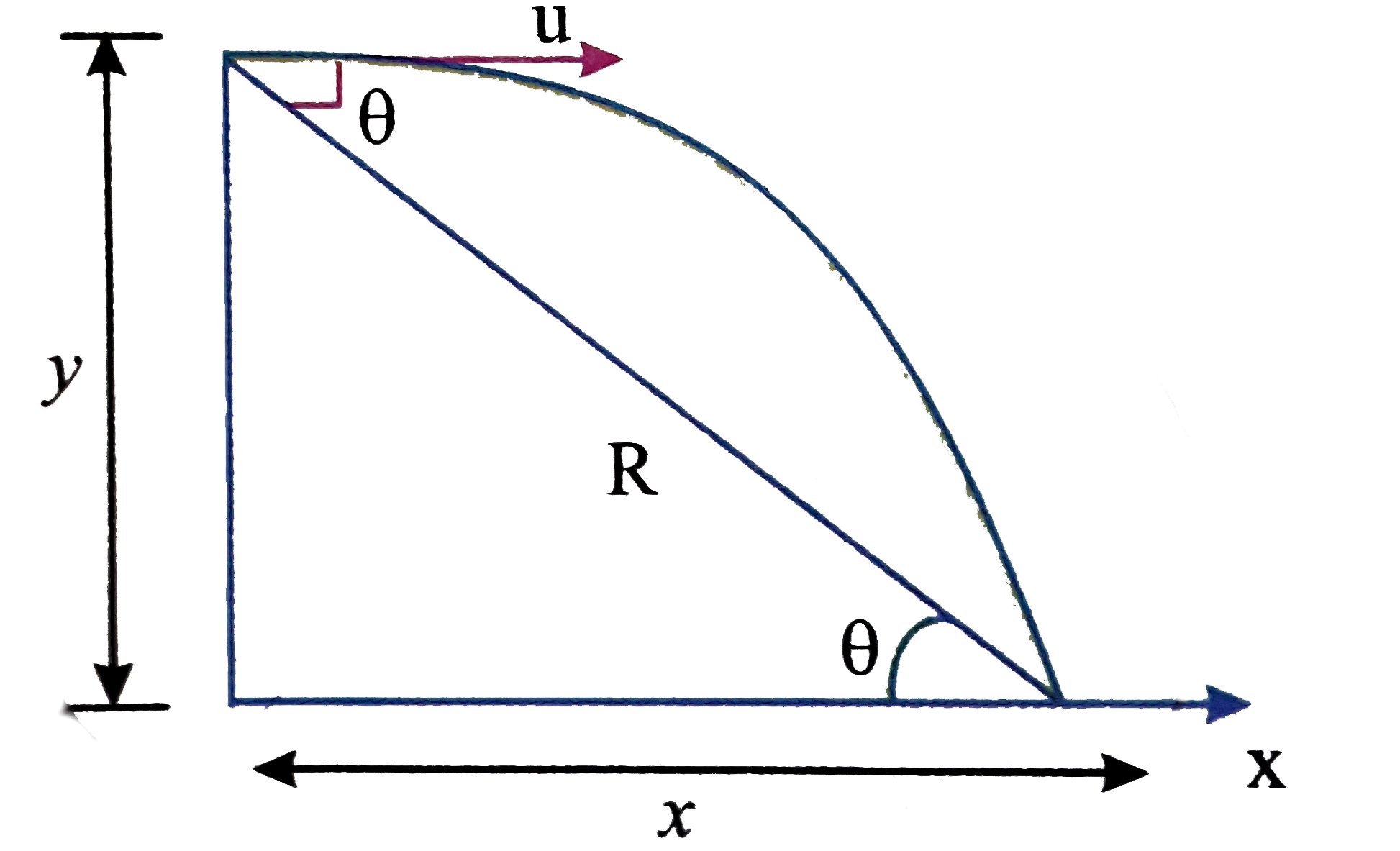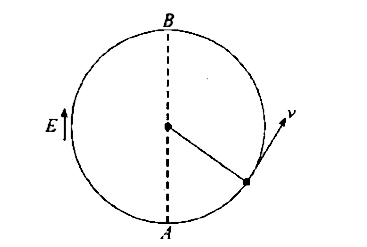A particle of mass m attached to a string of length l is descending circular motion on a smooth plane inclined at an angle α with the horizontal. For the particle to reach the highest point its velocity at the lowest point should exceed.
√5gl
√5gl(cosα+1)
√5gl/tanα
√5glsinα
The correct Answer is:D
To solve the problem, we need to determine the minimum velocity required at the lowest point of the circular path for the particle to reach the highest point in its motion. Here’s a step-by-step solution:
Step 1: Understand the Forces Acting on the Particle
When the particle is at the lowest point of its circular motion, it experiences two forces:
- The gravitational force acting downward, which can be resolved into two components: one along the incline mgsinα and one perpendicular to the incline mgcosα.
- The tension in the string acting upward.
Step 2: Determine the Effective Gravitational Force
At the lowest point, the effective gravitational force acting on the particle can be considered as gsinα. This is because the particle is moving along the inclined plane, and we only need to consider the component of gravitational force acting down the incline.
Step 3: Apply the Condition for Circular Motion
For the particle to complete the circular motion and reach the highest point, it must have sufficient velocity at the lowest point. The centripetal force required to keep the particle in circular motion at the lowest point is provided by the tension in the string and the gravitational force acting on the particle.
Step 4: Use the Formula for Velocity at the Lowest Point
The minimum speed v at the lowest point for the particle to reach the highest point in a vertical circular motion is given by the formula:
v=√geffective⋅l
where geffective=gsinα.
Step 5: Substitute the Effective Gravitational Force
Substituting geffective:
v=√(gsinα)⋅l
Step 6: Calculate the Required Velocity
To find the minimum velocity at the lowest point, we can express it as:
v=√glsinα
Step 7: Consider the Condition for Reaching the Highest Point
For the particle to reach the highest point, its velocity at the lowest point must exceed a certain threshold. This threshold velocity can be derived from the energy conservation or dynamics of circular motion.
Final Expression
The final expression for the minimum velocity at the lowest point for the particle to reach the highest point in its circular motion is:
v≥√5glsinα
Conclusion
Thus, the velocity at the lowest point should exceed √5glsinα for the particle to successfully reach the highest point in its circular motion.
---
When the particle is at the lowest point of its circular motion, it experiences two forces:
- The gravitational force acting downward, which can be resolved into two components: one along the incline mgsinα and one perpendicular to the incline mgcosα.
- The tension in the string acting upward.
At the lowest point, the effective gravitational force acting on the particle can be considered as gsinα. This is because the particle is moving along the inclined plane, and we only need to consider the component of gravitational force acting down the incline.
For the particle to complete the circular motion and reach the highest point, it must have sufficient velocity at the lowest point. The centripetal force required to keep the particle in circular motion at the lowest point is provided by the tension in the string and the gravitational force acting on the particle.
The minimum speed v at the lowest point for the particle to reach the highest point in a vertical circular motion is given by the formula:
v=√geffective⋅l
where geffective=gsinα.
Substituting geffective:
v=√(gsinα)⋅l
To find the minimum velocity at the lowest point, we can express it as:
v=√glsinα
For the particle to reach the highest point, its velocity at the lowest point must exceed a certain threshold. This threshold velocity can be derived from the energy conservation or dynamics of circular motion.
The final expression for the minimum velocity at the lowest point for the particle to reach the highest point in its circular motion is:
v≥√5glsinα
Thus, the velocity at the lowest point should exceed √5glsinα for the particle to successfully reach the highest point in its circular motion.
Topper's Solved these Questions
- CIRCULAR MOTIONBOOK - DC PANDEY ENGLISHCHAPTER - CIRCULAR MOTIONEXERCISE - JEE Advanced
24 Videos
- CIRCULAR MOTIONBOOK - DC PANDEY ENGLISHCHAPTER - CIRCULAR MOTIONEXERCISE - More than One Option is Correct
13 Videos
- CIRCULAR MOTIONBOOK - DC PANDEY ENGLISHCHAPTER - CIRCULAR MOTIONEXERCISE - Subjective Questions
2 Videos
- CENTRE OF MASS, LINEAR MOMENTUM AND COLLISIONBOOK - DC PANDEY ENGLISHCHAPTER - CENTRE OF MASS, LINEAR MOMENTUM AND COLLISIONEXERCISE - Level 2 Subjective
21 Videos
- COMMUNICATION SYSTEMBOOK - DC PANDEY ENGLISHCHAPTER - COMMUNICATION SYSTEMEXERCISE - Only One Option is Correct
27 Videos
Similar Questions
A particle is fired with velocity u making angle θ with the horizontal.What is the change in velocity when it is at the highest point?
View SolutionA particle is projected horizontally with a speed u from the top of plane inclined at an angle θ with the horizontal. How far from the point of projection will the particle strike the plane ?

View SolutionA particle of mass m is attached to a string of length L and given velocity √10gL in the horizontal direction at the lowest point. Find tension in the string when the particle is at (i) lowest position (ii) highest position,
View SolutionA particle is projected with a velocity u making an angle θ with the horizontal. The instantaneous power of the gravitational force
View SolutionIf a particle of mass m is thrown with speed at an angle 60° with horizontal, then angular momentum of particle at highest point about point of projection is
View SolutionA particle of mass m is projected with a velocity v at an angle of θ with horizontal. The angular momentum of the particle at the highest point of its trajectory is equal to :
View SolutionA particle of mass m is tied to a string of length L and whirled into a horizontal plan. If tension in the string is T then the speed of the particle will be :
View SolutionA particle of mass m and charge Q is attached to a string of length l. It is whirled in a vertical circle in the region of an electric field E as shown in the figure-5.105.What is the speed given to the particle at the point B,so that tension in the string when the particle is at A is ten times the weight of the particle?

View SolutionA particle of mass m is projected with speed u at an angle θ with the horizontal. Find the torque of the weight of the particle about the point of projection when the particle is at the highest point.
View SolutionA particle of mass m is projected with speed u at an angle θ with the horizontal. Find the torque of the weight of the particle about the point of projection when the particle is at the highest point.
View Solution
